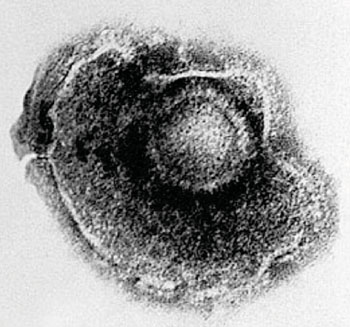Multiplex Assays Detect HSV-1/2 And Varicella Zoster Virus
By LabMedica International staff writers
Posted on 13 Jan 2015
The performance of two multiplex real-time polymerase chain reactions (PCR) to individual real-time PCR for the detection of herpes simplex virus-1 (HSV-1), HSV-2, and Varicella zoster virus (VZV) from clinical specimens have been compared. Posted on 13 Jan 2015
Viral culture has been considered the gold standard test, although molecular methods have been shown to be more rapid and sensitive and currently, most laboratories perform real-time PCR for the detection of HSV and VZV.

Image: Transmission electron micrograph (TEM) of the Varicella zoster virus (Photo courtesy of Dr. Erskine Palmer).
Scientists at the Mayo Clinic (Rochester, MN, USA) tested 26,186 samples that were submitted to their laboratory for routine testing by HSV-1/2 real-time PCR analyte-specific reagents (ASR) and/or a VZV laboratory-developed test (LDT) between November 2013 and March 2014. Testing by the routine methods included nucleic acid extraction using the MagNA Pure (Roche; Basel, Switzerland) and analysis on the Roche LightCycler 2.0.
The two multiplex assays that were compared to the routine PCR were the US Food and Drug Administration (FDA; Silver Springs, MD, USA)-approved Lyra HSV 1+2/VZV assay (Quidel; San Diego, CA, USA) and the Simplexa HSV-1/2 and VZV combined analyte specific reagents (Focus Diagnostics; Cypress, CA, USA). Samples were also tested by combining the Focus Diagnostics ASRs for HSV 1 + 2 and VZV and testing was then performed on the Focus 3M Integrated Cycler.
The results were compared to a consensus standard, defined as the result obtained by at least two of the three molecular methods. The sensitivity of the Quidel assay ranged from 92.0% for HSV-1 to 97.7% for HSV-2, while the specificity for all targets was 100%. The Focus assay demonstrated 100% sensitivity for all targets, and the percent specificity ranged from 96.8% for HSV-1 to 100% for HSV-2 and VZV.
The authors concluded that for the detection of HSV-2 in cerebrospinal fluid (CSF), the Focus assay showed 100% sensitivity and specificity, while the Quidel HSV-2 method exhibited a sensitivity of 87.5% (7/8) and specificity of 100% (18/18). Future studies evaluating a larger number of CSF samples are needed to better define the performance of these tests. Multiplex assays for HSV-1/2 and VZV offer a promising option for clinical laboratories seeking to reduce hands-on and turnaround times. The study was published online in the January issue of the journal Diagnostic Microbiology and Infectious Disease.
Related Links:
Mayo Clinic
Roche
Quidel














